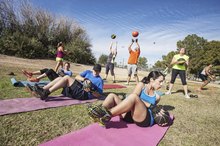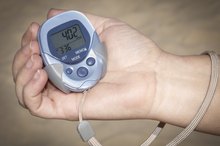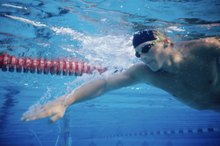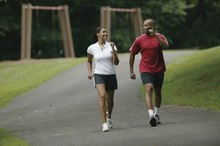The number of calories you burn in a triathlon depend on a number of factors including the length of the triathlon swim, cycle and run sections. Additionally, your calories burned will vary according to your weight and environmental factors such as the temperature of the water. In general, the heavier you are, the more calories you will burn completing a triathlon 1.
Swim
In a sprint-distance triathlon, the swim is 750 m, the cycling portion covers 20 km and the run is 5 km. In pool-based triathlons, the swim may be a reduced distance such as 400 or 500 meters. For a 150-lb person, swimming burns 682 calories per hour. Results from the 2010 Burlington VT sprint triathlon indicate that the swim typically takes between 7.5 and 20 minutes. Therefore, the swim section of a sprint triathlon would burn between 85 and 227 calories.
- In a sprint-distance triathlon, the swim is 750 m, the cycling portion covers 20 km and the run is 5 km.
- In pool-based triathlons, the swim may be a reduced distance such as 400 or 500 meters.
Cycle
Calories Burned Biking 15 MPH
Learn More
At a fast cycling speed of 20 miles per hour, completing the 20-km cycle section of a sprint triathlon would take 37.5 minutes. For a 150-lb triathlete, cycling this distance at this speed would burn approximately 682 calories. At a body weight of 120 lb, a triathlete completing the same distance in the same time would burn only 545 calories. Slowing down the cycling pace will generally increase the number of calories burned over the same distance, as the overall time taken on the cycle section will be longer.
- At a fast cycling speed of 20 miles per hour, completing the 20-km cycle section of a sprint triathlon would take 37.5 minutes.
- At a body weight of 120 lb, a triathlete completing the same distance in the same time would burn only 545 calories.
Run
Running at a speed of six miles per hour -- equivalent to a 10-minute mile pace -- a 150-lb triathlete would burn 352 calories over the 5 km distance of the sprint triathlon run. At the same body weight, running significantly faster slightly decreases the overall calories burned -- at a speed of 10 miles per hour -- a 6-minute mile -- the same athlete would burn only 345 calories over the 5 km.
Variables
How Many Calories Do I Burn Doing Barry's Bootcamp?
Learn More
Your body weight is the biggest variable determining the number of calories you burn in a triathlon. For example, a 150-lb swimmer will burn 682 calories per hour, but a 90-lb swimmer will burn only 409 calories for every hour of swimming. For a 150-lb athlete completing the swim in 20 minutes, the cycling section in roughly 38 minutes and the 5k run in 31 minutes, the total calories burned in a sprint-distance triathlon would be 1,261. Additional calories would be burned during transitions between the disciplines.
- Your body weight is the biggest variable determining the number of calories you burn in a triathlon.
- For a 150-lb athlete completing the swim in 20 minutes, the cycling section in roughly 38 minutes and the 5k run in 31 minutes, the total calories burned in a sprint-distance triathlon would be 1,261.
Related Articles
References
- CSG Network: Calorie Burn Calculator
- Calorie Burners: Activities that turn up the heat. American Council on Exercise
- Li SSW, Chan OHT, Ng TY, et al. Gender Differences in Energy Expenditure During Walking With Backpack and Double-Pack Loads. Hum Factors. 2018;:18720818799190. doi:10.1177/0018720818799190
- Chang CH, Lin KC, Ho CS, Huang CC. Accuracy of the energy expenditure during uphill exercise measured by the Waist-worn ActiGraph. J Exerc Sci Fit. 2019;17(2):62-66. doi:10.1016/j.jesf.2019.01.003
- Champagne CM, Broyles ST, Moran LD, et al. Dietary intakes associated with successful weight loss and maintenance during the Weight Loss Maintenance trial. J Am Diet Assoc. 2011;111(12):1826-35. doi:10.1016/j.jada.2011.09.014
- LAYDEN, J. D., PATTERSON, M. J., & NIMMO, M. A. (2002). Effects of reduced ambient temperature on fat utilization during submaximal exercise. Medicine & Science in Sports & Exercise, 34(5), 774–779. doi:10.1097/00005768-200205000-00008
- Li, S. S. W., Chan, O. H. T., Ng, T. Y., Kam, L. H., Ng, C. Y., Chung, W. C., & Chow, D. H. K. (2018). Gender Differences in Energy Expenditure During Walking With Backpack and Double-Pack Loads. Human Factors: The Journal of the Human Factors and Ergonomics Society, 61(2), 203–213. doi:10.1177/0018720818799190
- Michael N. Sawka,1 C. Bruce Wenger, Andrew J. Young, and Kent B. Pandolf. Physiological Responses to Exercise in the Heat. Copyright 1993 by the National Academy of Sciences. All rights reserved.
- Morio, B., Beaufrere, B., Montaurier, C., Verdier, E., Ritz, P., Fellmann, N., … Vermorel, M. (1997). Gender differences in energy expended during activities and in daily energy expenditure of elderly people. American Journal of Physiology-Endocrinology and Metabolism, 273(2), E321–E327. doi:10.1152/ajpendo.1997.273.2.e321
- Yue, A. S. Y., Woo, J., Ip, K. W. M., Sum, C. M. W., Kwok, T., & Hui, S. S. C. (2007). Effect of age and gender on energy expenditure in common activities of daily living in a Chinese population. Disability and Rehabilitation, 29(2), 91–96. doi:10.1080/09638280600662232
- Ainsworth, B.; Haskell, W.; Herrmann, S. et al. Compendium of Physical Activities: A Second Update of Codes and MET Values. Med Sci Sports Exercise. 2011;43:1575. DOI: 10.1249/MSS.0b013e31821ece12.
- American Council on Exercise. (2009) Fit Facts - Calories Burners: Activities That Turn Up the Heat. San Diego, California: American Council on Exercise.
Writer Bio
Jae Allen has been a writer since 1999, with articles published in "The Hub," "Innocent Words" and "Rhythm." She has worked as a medical writer, paralegal, veterinary assistant, stage manager, session musician, ghostwriter and university professor. Allen specializes in travel, health/fitness, animals and other topics.









